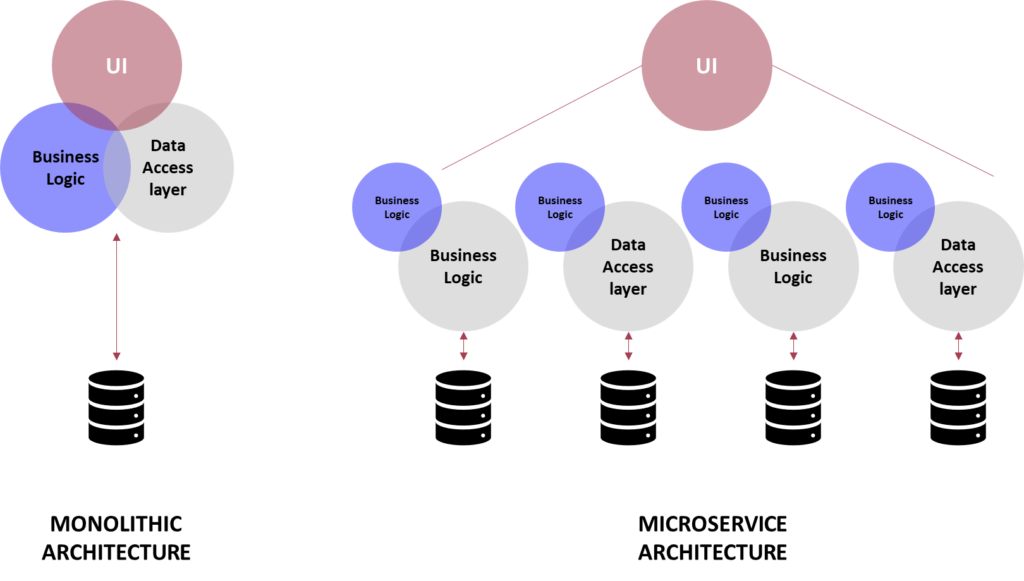written by Hitesh Kumar
What is Microservice Application Architecture?
Microservice application architecture comprises a combination of small and self-sufficient services where each service is self-contained. In microservice architecture, every service must be deployed as a single business component and operated independently. This architecture has become a popular choice for application implementation in the past several years due to its agility, scalability, and management.

Characteristics that make microservice architecture a better choice:
- Each service is independent
- Each service could be technology agnostic
- Management and monitoring of each service is different
- Services interact with other services using APIs
- Database of each service could be independent
- Scalability at the individual level
- Focused on a single business outcome
- Isolated modules
- Vertical scaling

What is Monolithic Application Architecture?
Most of us are very much aware of monolithic application architecture, an approach in which all components in an application are connected in a single unit. There are no isolated modules or services, separate codebases, or separate databases. The deployment in the monolithic application generally varies by each application. The management of the monolithic application is also very easy as compared to microservices architecture. For a very small application, the monolithic approach seems to work well unless the application grows on a massive scale.
Here are a few characteristics of the monolithic approach:
- A single codebase and self-contained application
- Tightly coupled modules
- Utilize single technology stack
- Horizontal scaling
- Very slow deployment

A High-Level Comparison of Monolithic and Microservice Architecture.
The chart below shows a comparison between both approaches.
Microservices Solve Monolithic Issues
We have a holistic idea about both the architectures, as well as some major factors of microservices and monolithic architecture. Let’s look at how microservices can help solve the problems which occur with a monolithic architecture.
We will address some of those pain points here:
Development/Technology Stack
Because the microservices are loosely coupled and isolated from other microservices, you can easily pick up different technology stacks, whereas microservices can communicate with other stacks over secure APIs.
This approach provides a good amount of flexibility and allows the developer to choose their favorite stacks.
Point of Failure
On any given day, the entire application can go down due to issues in the application. This is the major disadvantage of using monolithic applications. If a single component fails, the entire application fails. The opposite is true of microservices. Those applications work independently as a single module. Should a single microservice go down, it would not take down the entire application.
Ease of deployment
A microservice can be deployed as a single unit and the deployment cycle is very fast compared to the monolithic application. In a monolithic application, we would need to recreate the entire build and perform the deployment of the entire application.
Faster recovery
As mentioned above, if the point of failure is a single microservice then the recovery steps that need to be performed occur on that microservice and not on the entire application. The testing cycle, debugging, and monitoring also need to be implemented on the single microservices rather than a complete application.
Reusable modules
We can reuse the microservices-based modules on other applications based on the requirement of the workload. A very small single unit is easy to incorporate rather than a complete codebase.
What is the right choice?
Although there is no doubt that microservice architecture is modern, scalable, agile, and rapidly adaptable, however, the monolithic approach is still being used in some cases. The popularity of the microservice approach is increasing day by day beside of its complexity and intricate management. There is not a single fit for all rules when it comes to choosing between both the architectures. There are still use cases where an enterprise chooses monolithic over microservice because of its simplicity, easier management, normal learning curve, etc.
Use microservices if:
- Your development team has a very steep learning curve
- You are facing complex problems daily such as, slow deployments, complex test cycles, bug management, performance issues, etc.
- Your application is growing on a massive scale
- Your prime concern is agility and adaptability of the application
- You have enough budget and time to develop the microservices
- You are ready to handle the complex monitoring system
- The technology-agnostic stack is the main requirement
Use the monolithic approach if:
- You have a traditional development and deployment team
- Your application usages are limited
- Your budgets and time are limited
- You are not concerned about agility and adaptability
- Applications are simple and easy to develop
- You are not facing performance, testing, or bug management issues
Sterling offers comprehensive services to help the business users get the true value of Amazon Cloud, migration, deployment, and management. Being an AWS Cloud partner, Sterling can help you build cloud-based applications for your business. With the core expertise of years in cloud consulting, we have a robust understanding of the solutions necessary to meet the demands of what businesses need. The Sterling cloud team will work with you to identify solutions to fulfill your custom requirements and more significantly, reduce areas of risk and the mitigating processes necessary to avoid them in the future.
Reach out to us on connect@sterling.com for more information, product assistance, and demos.

